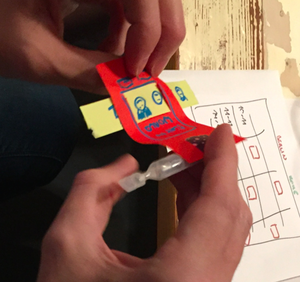The Thing from the Future

Help a group to time-travel and tap their imagination by fictional objects.
With tangible objects and the stories your participants make up w/ them you'll get so much richer inputs and context to inform joint visioning / strategizing:
The future doesn't look that far away when you can pick it off the shelf.
Goal
Open a group for speculative thinking. Spark imagination and create conversation pieces / artefacts to get into a generative dialogue.
Materials
Instructions
Structuring Invitation
At the begin of a strategic, future oriented workshop invite people to explore their joint desireable future by fictional objects.
How Space Is Arranged and Materials Needed
- A group of max. 12 people around a table; ideally split up into groups of 4
- "Time-travelled" objects from the future (e.g. objects out of the context of the group w/ an added extra/irritation; repurposed packaging; little boxes w/ pearls/pills)
- A table w/ prototyping-material (washi-tape, glue, connectors, paper in interesting colors, play-dough, scissors...)
- Sticky notes & markers to label objects
- Pen & paper to take notes after the sharing of the fictional objects
- Flip chart may be needed with a large group to collect answers
How Participation Is Distributed
- Everyone is included
- Everyone has an equal opportunity to contribute at each table
- Split into smaller groups when more than 7; otherwise the sharing/storymaking will take too long
Sequence of Steps and Time Allocation
- State that you time-travelled & depict a desired state of the future your group can relate to (3 min). Say that you brought back objects from the future. As time travel does not work seamlesslessly, the objects are not functioning anymore, some elements got lost as well as packaging and descriptions.
- Unpack the objects and place them on the table. Have a choice of objects that is number of seats at the table +3 (don't have too many, otherwise it's hard for people to choose). Invite everyone to pick one of the objects (5 min).
- Invite people to work with their object for 10 minutes to make it more plausible. Ask: "what could it be? What is missing to make the function of the object more plausible (a logo, a label, a packaging, color, further elements...)?"
"Use the material at the table to change your object!" - Prepare for the presentation (1 min): Invite everyone to write a working title for their object on a post-it, clean the table of everything that is not belonging to the objects and place their object in front of them (1min; photo opportunity!)
- Harvest (10-15 min): everyone introduces her object, 1 min. each (split into two groups when more than 8 participants); allow the group to clarify elements w/ the presenter but ask them to not discuss the probability and refrain from judging / rating the object; document the stories (e.g. film the explanation or take pics)
- Reflect (10-20 min): This part is your transition to end the prototyping & storymaking and use it to inform what you came together for. There are multiple options. I like to invite each participant individually to reflect on what they heard & capture on a paper (4 min). You can use the structure What, So What, Now What for that end. After that you can continue with 1-2-4-all to further converge.
WHY? Purposes
- Add context and tangibility to speculative thinking
- Highly inclusive: everyone imagines & shares & get's help by her object to do so.
- Create tangible artefacts for a desireable future
- Develop a mutual understanding
Tips and Traps
- Too much choice - keep the number of objects to pick of in a good proportion to number of participants and purposefully curate material and tools at hand - limitation sparks ingenuity
- Pick time-travelled objects out of the context of your group and alter a bit
- Have some flashy material at hand (e.g. repurposed wrapping foil, interesting tape) for participants' inner child - unleash the fun to use glitter glue once more in your lifetime ;-)
- Don't skip the reflection part if you do this in a strategic workshop; otherwise the session will be perceived as an activity without connection to the rest - a missed opportunity!
Examples
Creation of conversation starters to kick-off a panel discussion that explores the future of a profession/industry at a business conference
Opening up a strategic planning workshop/away-day
Generation of content-pieces (e.g. films) to inform and inspire discussions within a (virtual) community
Attachments
- Bildschirmfoto 2017-07-06 um 15.32.47.png
- IMG_8124.jpg
- IMG_8191.jpg
- IMG_8187.jpg
- IMG_8171.jpg
- IMG_8120.jpg
Background
Inspired by the Design Fiction methodology mentioned here.